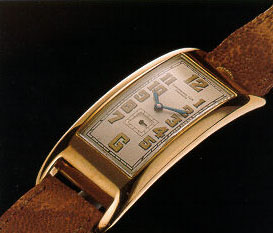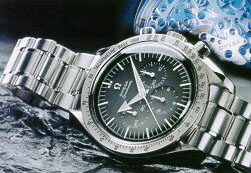The Movado Polyplan It was long, slim, and curved to fit the wrist - as unlike a pocketwatch as it could be. That was, if fact, the point. The Movado Polyplan, patented in 1912, when the wristwatch was still in swaddling clothes, was a toast to the fresh design possibilities the wristwatch presented. It was a show-offy shout of "Vive la difference!" to a world that had for centuries believed that watches should be round, flat, and for most of the time at least, out of sight. It was long, slim, and curved to fit the wrist - as unlike a pocketwatch as it could be. That was, if fact, the point. The Movado Polyplan, patented in 1912, when the wristwatch was still in swaddling clothes, was a toast to the fresh design possibilities the wristwatch presented. It was a show-offy shout of "Vive la difference!" to a world that had for centuries believed that watches should be round, flat, and for most of the time at least, out of sight.
The Polyplan wasn't just a fashion statement, but, far more famously, a technical triumph. Inside its elongated, sharply curved case was a curved movement - or a bent one, to be more precise. The two ends of the main plate were angled downwards at 25 degrees so that they followed the shape of the case - an attenuated rectangle, oval or tonneau - and enabled more efficient use of the space inside. The movement's balance could therefore be bigger, and the watch more accurate, than it would have been if it had a straight-line movement. (The name "Polyplan" comes from the movement's being built on three planes - the prefix "poly" meaning "more than one.") Watch companies have had a powerful urge to curve ever since. The Gruen Curvex of the 1930s was the most famous example but there have been hundreds of others. This year's watch fair in Basel, Switzerland, the world's most important showcase for new watch models, brought out a huge crop of curved beauties, the largest in years, all owing something to their wrist-hugging predecessor.
How did it get there? The story begins in the early '60s when NASA needed to find a chronograph watch accurate and durable enough for astronauts to wear in space. Until then, astronauts had been allowed to wear whatever watches they wanted. But now that NASA was planning space walks and, ultimately, moon walks, astronauts needed a chronograph they could count on to time their out-of-spaceship exploits. It would have to be able to withstand any extra-terrestrial eventuality - lethal temperatures (the surface of the moon ranges from minus 160 degrees to plus 120 degrees Celsius), abrupt changes of pressure and bone-rattling vibrations. Agency officials bought chronographs from several watch brands and submitted them to strenuous endurance tests - the most tortuous any watch had ever undergone. Watch hands twisted in agony. Watch crystals warped. But not those of the Speedmaster. Only it survived. That's why, when the Eagle landed on the Sea of Tranquility on July 20, 1969, the Speedmaster landed with it. Buzz Aldrin wore his as he stepped onto the lunar surface 15 minutes after Neil Armstrong's "giant leap for mankind." But wait. Didn't Armstrong have a Speedmaster, too? And didn't he wear it when he made that famous first step? He did and he would have if not for a technical glitch. After the lunar module landed, Aldrin noticed that its clock had stopped. Armstrong left his Speedmaster onboard as a back-up because it, or course, hadn't |
 Wristwatches have visited some pretty heady places - the top of Mount Everest, the South Pole, the bottom of the Marianas Trench. But no watch has traveled to as exotic a locale as the Omega Speedmaster has: the surface of the moon. The "Moon Watch," as Omega dubbed it, was on the wrists of the pioneering Apollo XI astronauts and aboard every moon-bound spaceship before and after.
Wristwatches have visited some pretty heady places - the top of Mount Everest, the South Pole, the bottom of the Marianas Trench. But no watch has traveled to as exotic a locale as the Omega Speedmaster has: the surface of the moon. The "Moon Watch," as Omega dubbed it, was on the wrists of the pioneering Apollo XI astronauts and aboard every moon-bound spaceship before and after.
